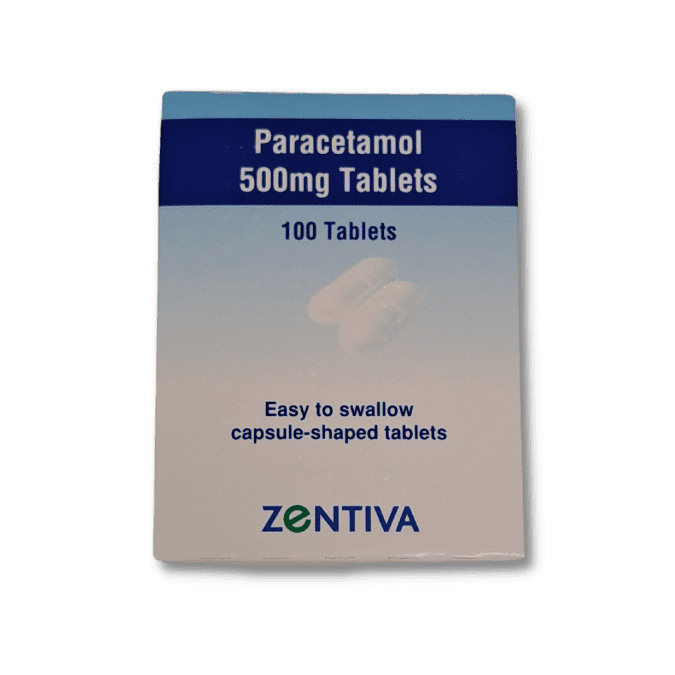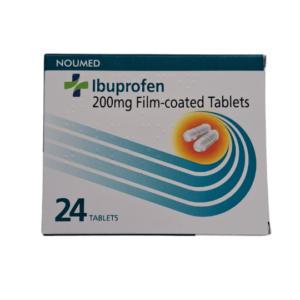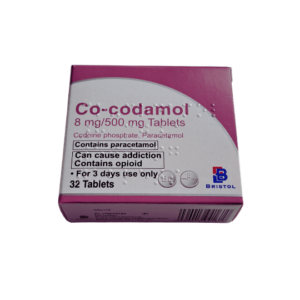
The image is for illustration purposes only.
The brand supplied may vary.
£5.98
Pack Size: 100 tablets
Prescription Only Medicine (POM)
♦ Mild to moderate pain relief (pain killers).
♦ Relief from aches and pains, headaches, cold & flu symptoms.
♦ Easy-to-swallow caplets (capsule-shaped).
Paracetamol 500mg tablets are a common over-the-counter medication used to relieve mild to moderate pain and reduce fever.
Paracetamol is the active ingredient in the medication, and it works by blocking the production of certain chemicals in the body that cause pain and fever.
The recommended adult dose of paracetamol is typically 500mg (1 tablet) to 1000mg (2 tablets) every four to six hours, up to a maximum of 4000mg (8 tablets) in 24 hours. It is important to follow the dosage instructions carefully and not exceed the recommended maximum dose, as taking too much paracetamol can cause liver damage.
It is also important to read the patient information leaflet that comes with the medication for any other specific instructions or warnings.
You can buy paracetamol 500mg tablets, 32 pack or 100 pack online from Online Chemist private doctor. Start a free consultation today!
Paracetamol tablets are a type of medication that contains the active ingredient paracetamol.
Paracetamol is a commonly used painkiller and reduce fever that works by blocking the production of certain chemicals in the body that cause pain and fever.
Paracetamol tablets are typically taken orally with water and are available in 500mg tablets or liquid.
They are commonly used to relieve mild to moderate pain associated with headaches, menstrual cramps, toothaches, and musculoskeletal injuries.
Paracetamol tablets are also used to reduce fever in patients with conditions such as the flu or other infections.
Paracetamol is a medication used to relieve pain and reduce fever. It is an over-the-counter medication that is commonly used to treat mild to moderate pain associated with headaches, toothaches, menstrual cramps, musculoskeletal injuries, and other conditions.
Paracetamol works by blocking the production of certain chemicals in the body that cause pain and fever.
In addition to its pain-relieving and fever-reducing properties, paracetamol may also be used to treat other conditions, such as:
Osteoarthritis: Paracetamol may be used to relieve pain and stiffness associated with osteoarthritis, a degenerative joint disease that affects millions of people worldwide.
Back pain: Paracetamol may be used to relieve pain associated with back pain, a common condition that affects many people at some point in their lives.
Cold and flu: Paracetamol may be used to reduce fever and relieve the symptoms associated with colds and flu, such as headache, body aches, and sore throat.
Dental pain: Paracetamol may be used to relieve pain associated with dental procedures, such as tooth extraction or root canal therapy.
It is important to follow the recommended dosage instructions and not exceed the maximum daily dose of paracetamol to avoid possible side effects and liver damage. It is always best to consult your pharmacist before taking any medication, especially if you have any underlying medical conditions or are taking other medications.
Paracetamol works by inhibiting the production of prostaglandins in the body. Prostaglandins are chemicals produced by the body that are responsible for pain, inflammation, and fever. Paracetamol blocks the enzyme cyclooxygenase (COX), which is responsible for producing prostaglandins. By inhibiting COX, paracetamol reduces the production of prostaglandins, which in turn reduces pain, inflammation, and fever.
Paracetamol also acts on the hypothalamus in the brain, which is responsible for regulating body temperature. By reducing the production of prostaglandins, paracetamol helps to lower body temperature and reduce fever.
Paracetamol is a selective COX-2 inhibitor, which means that it mainly inhibits the production of COX-2, while having minimal effects on COX-1. COX-1 is an enzyme that is responsible for producing prostaglandins that protect the stomach lining and promote blood clotting. By having minimal effects on COX-1, paracetamol is less likely to cause stomach irritation and bleeding, which can be a side effect of other pain-relieving medications such as nonsteroidal anti-inflammatory drugs (NSAIDs).
Paracetamol usually starts to work within 30 minutes to an hour after taking it. However, the exact time it takes to work can vary depending on several factors, including the individual’s metabolism, the dosage, and the formulation of the medication (e.g., regular or fast-acting).
The effects of paracetamol usually last for about four to six hours, but this can also vary depending on the individual and the dose. It is important to follow the recommended dosage instructions and not exceed the maximum daily dose to avoid possible side effects and liver damage.
Paracetamol is a safe and effective medication when taken as directed. However, it is important to remember that it is not a cure for underlying conditions that may be causing pain or fever. If symptoms persist or worsen, it is important to consult a healthcare professional for further evaluation and treatment.
Paracetamol is usually taken orally with water. The exact dosage and frequency of use may vary depending on the individual, the condition being treated, and other factors such as age and weight. It is important to follow the recommended dosage instructions and not exceed the maximum daily dose to avoid possible side effects and liver damage.
The typical recommended dosage of paracetamol for adults is 500mg to 1000mg every four to six hours, up to a maximum of 4000mg per day. However, the maximum daily dose may be lower in certain individuals, such as those with liver or kidney disease.
For children, the dosage of paracetamol is based on their age and weight. It is important to follow the recommended dosage instructions for children and not exceed the maximum daily dose.
It is generally safe to take paracetamol and ibuprofen together, but it is important to follow the recommended dosage instructions and not exceed the maximum daily dose of either medication. Paracetamol and ibuprofen work in different ways to relieve pain and fever, so taking them together may provide more effective pain relief than taking either medication alone.
However, it is important to note that both paracetamol and ibuprofen can have side effects, especially if taken in high doses or for prolonged periods of time. Possible side effects of paracetamol include liver damage, while possible side effects of ibuprofen include stomach irritation and bleeding.
It is generally not recommended to take paracetamol and naproxen together unless specifically advised to do so by a healthcare professional. Both paracetamol and naproxen are pain-relieving medications that work in different ways, and taking them together may increase the risk of side effects.
Naproxen belongs to a class of medications called nonsteroidal anti-inflammatory drugs (NSAIDs), which can cause stomach irritation and bleeding, especially when taken in high doses or for prolonged periods of time. Paracetamol tablets, on the other hand, is less likely to cause stomach irritation and bleeding.
If you are experiencing pain or fever and are considering taking both paracetamol and naproxen, it is important to consult a healthcare professional first. They can advise you on the appropriate dosage and frequency of use based on your individual needs and medical history. They may also recommend alternative pain-relieving options that are better suited for your condition.
Paracetamol and codeine are often used together to treat moderate to severe pain, as they work in different ways to relieve pain. Paracetamol is a pain reliever and fever reducer, while codeine is a stronger pain reliever that works by blocking pain signals to the brain.
However, it is important to note that codeine can be habit-forming and can cause side effects such as dizziness, drowsiness, and constipation. Paracetamol can also cause side effects such as liver damage when taken in high doses or for prolonged periods of time.
If you are considering taking paracetamol and codeine together, it is important to follow the recommended dosage instructions and not exceed the maximum daily dose of either medication. It is also important to consult a healthcare professional before taking these medications together, especially if you have any underlying medical conditions or are taking other medications.
It is also important to note that some medications already contain paracetamol and/or codeine, so it is important to read the label and instructions on the packaging carefully to avoid unintentionally taking too much of either medication.
Paracetamol is generally considered safe to take during pregnancy when used at the recommended dosage and frequency of use. It is commonly used to relieve mild to moderate pain and fever during pregnancy.
However, it is important to consult a healthcare professional before taking any medications during pregnancy, as some medications may pose risks to the developing fetus. The healthcare professional can advise you on the appropriate dosage and frequency of use based on your individual needs and medical history.
It is also important to note that some medications may contain other ingredients in addition to paracetamol, such as codeine or caffeine, which may not be safe to take during pregnancy. It is important to read the label and instructions on the packaging carefully before taking any medications during pregnancy.
The amount of paracetamol that can be dangerous varies depending on several factors, including the age, weight, and overall health of the individual, as well as the amount of paracetamol ingested and the time elapsed since ingestion.
In general, taking more than the recommended maximum daily dose of paracetamol, which is usually 4000mg (8 tablets) for adults, can be dangerous and may cause liver damage or even liver failure. In some cases, even lower doses of paracetamol can cause liver damage, especially in individuals with pre-existing liver disease or those who consume alcohol regularly.
It is important to always follow the recommended dosage instructions and not exceed the maximum daily dose of paracetamol. If you suspect that you have taken too much paracetamol, or if you experience symptoms such as nausea, vomiting, abdominal pain, or yellowing of the skin or eyes, seek medical attention immediately.
Paracetamol is generally considered safe when used at the recommended dosage and frequency of use. However, like any medication, it can have side effects, especially when taken in high doses or for prolonged periods of time.
Common side effects of paracetamol include:
In rare cases, paracetamol can cause serious side effects, such as liver damage, when taken in excessive amounts or over prolonged periods of time. Symptoms of liver damage include yellowing of the skin or eyes, abdominal pain, and dark urine.
If you experience any unusual symptoms while taking paracetamol, it is important to seek medical attention immediately. It is also important to consult a healthcare professional before taking paracetamol if you have any underlying medical conditions or are taking other medications, as they may interact with paracetamol and increase the risk of side effects.
Paracetamol is generally considered safe when used at the recommended dosage and frequency of use. However, there are some situations in which paracetamol should be used with caution or avoided altogether. These include:
It is important to consult a healthcare professional before taking paracetamol if you have any underlying medical conditions or are taking other medications. They can advise you on the appropriate dosage and frequency of use based on your individual needs and medical history.
Here are some useful UK reference links about paracetamol:
National Health Service (NHS) information about paracetamol: https://www.nhs.uk/medicines/paracetamol-for-adults/
Medicines and Healthcare products Regulatory Agency (MHRA) guidance on paracetamol: https://www.gov.uk/guidance/paracetamol-advice-for-use-in-patients-with-liver-or-kidney-problems
Patient information leaflet for paracetamol 500mg tablets: https://www.medicines.org.uk/emc/product/383/smpc
Royal Pharmaceutical Society (RPS) guidance on the safe use of paracetamol: https://www.rpharms.com/resources/quick-reference-guides/paracetamol
UK Clinical Knowledge Summaries (CKS) guidance on the management of pain: https://cks.nice.org.uk/pain-management-mild-to-moderate/
Authored by:

BPharm, MPharm, PGDip (Pharmacy), MRPharmS, IP
Pharmacist Independent Prescriber
GPhC Number: 2083409





Online Chemist
82 Middleton Road
Gorleston
Great Yarmouth
Norfolk, NR31 7AH
Phone: 01493 600610
Email: info@onlinechemistuk.net
Superintendent Pharmacist:
Obaidullah Zaman
BPharm, MPharm, PGDip (Pharmacy), MRPharmS, IP
GPhC Reg. Number: 2083409
Pharmacy Premises GPhC Reg. Number: 9011159
Monday 09:00 – 17:00
Tuesday 09:00 – 17:00
Wednesday 09:00 – 17:00
Thursday 09:00 – 17:00
Friday 09:00 – 17:00
Saturday Closed
Sunday Closed
Click here for driving directions
OnlineChemist is a trading name of Nomaz Limited.
Registered in England – 11349276.
© 2025 All rights reserved.